

 |
The AKSU 74 - The Krinkov |
 |
The AKSU74 or is the AK74SU or……. Either way it is the short-barrelled version of the AK74 and this one is a ‘Euro Deac’. So before I start looking at the SU, a little more on the euro deactivation standard. Over the last two years or so, there has been a steady influx of the euro deacs into the British market. The AK74M was the first to turn up; the first time I saw one was at Beltring in 2001. I was given the blurb by the importer and to be honest was highly sceptical as to the true legality of these deacs. There are now at least four companies who distribute the AK euro deac range which has grown to include the SU and other 74 type variants (as well as the GP rocket launcher, RPK and Druganov/SVD). The big issue with the euro deac standard is that it allows for fully moving parts, i.e. is equivalent to the UK pre 1995 standard.
So how can this be? Basically, it is possible because the AK range is built using pre-deactivated original parts (from the Ihzmash and Tula Arms Plants). These parts mean that it is built inert as a dummy assault rifle rather than being built live and then being subject to deactivation (and its standards). It is therefore not subject to licensing firearms control. It is proofed as being inert (by the Russian Proof House). Russia along with the UK and a number of other countries are a member of the C.I.P (International Proof Commission). As a signatory member of C.I.P, the UK has to recognise the proof marks of other member states – in this case, Russia.
Many UK dealers are still not willing to readily accept these deacs. My own outlook on this has changed over time. Apart from anything else, I think that if these inert weapons were not legal, this would have been picked up by now and a test case would be ongoing or indeed complete. To my knowledge no such case is taking place or has taken place. These AK’s are openly advertised on the Internet and in national magazines. They have been the subject of reviews in one particular magazine. All of this hardly represents a low profile approach in order to keep them ‘underground’ or not ‘let the cat out of the bag’. Additionally, I have contacted the Home Office regarding their legality. I actually managed to speak to someone who new exactly what I was talking about. He made the following points:
The only point made which could be seen as negative was that he said there was no UK law which specifically stated that the AK’s are legal. This is basically because the majority of UK law is decided on case history. No case has been brought (by the Police) against anyone importing/owning one of the AK’s; there is no case precedent and therefore no specific law.
With the price of old spec UK deacs simply rocketing at the moment, the AK euro deac range represents excellent value for money. This particular SU example retails for just under £400. It is new in the box with accessories. A UK old spec example (not necessarily in pristine condition) fetches in the region of double this amount! This review will therefore be split into two further sections; the history and use of the SU (blatantly ‘borrowed’ from another site!) and a look at the actual weapon (as presented as a euro deac).
Firstly then…. All about the AKSU….
The AKSU-74 is a modified version of the AK-74 assault rifle with a much shorter barrel (207 millimetres versus 413 millimetres) and a conical flash suppressor instead of a muzzle brake. Like the AKS-74, it has a folding metal stock. The overall length of the submachine gun is only 492 millimetres with stock folded or 728 millimetres with extended stock. The rear sight is a flip-type U-notch. The front sight is a cylindrical post. The Soviets designed the AKSU-74 as a weapon short enough to be handled easily when the crew enters and exits vehicles. The device at the end of the barrel functions as an expansion chamber to bleed off gases that would otherwise cause violent recoil. With a loaded weight of 3.106 kilograms, the submachine gun is considerably lighter than the assault rifle AK-74 and has a somewhat higher rate of fire.
|
Country Of Origin: |
Russia |
|
Designation: |
Sub-Machine Gun |
|
Cartridge: |
5.45 x 39.5 mm Soviet |
|
Production Date: |
1975 |
|
|
|
|
Weapon Dimensions: |
|
|
|
|
Length: |
|
|
|
Stock Extended: |
728 mm |
|
|
Stock Retracted: |
492 mm |
|
|
Barrel: |
206.5 mm |
|
|
Weight Empty: |
4 grooves, rh |
|
|
Rifling: |
30 rounds |
|
|
Mag Capacity: |
30 rounds |
|
|
Rate Of Fire: |
700 rds/min |
Take two….
The AKS-74U short assault rifle (the "U" suffix means "Ukorochennyj" in Russian = "Shortened" in English) has been developed in the late 1970s from the AKS-74 assault rifle. The AKS-74U was intended as a personal defense weapon for tanks, guns, helicopters and other vehicles crews, and for the special operations forces, who required a compact but relatively powerful individual automatic weapon. The AKS-74U has the size and effective range of a typical submachine gun, but has advantage of the general issue, assault rifle ammunition and magazines, as well as the parts interchangeability with the general issue assault rifle, the AK-74. Since its introduction the AKS-74U, unofficially known as a "Ksyukha" (variation of a Russian woman name) or "okurok" (cigarette stub), also had been issued to various Police and other Law Enforcement forces acres the USSR and the Post-USSR countries, including Russia. Interestingly, the AKS-74U is known in the USA as the "Krinkov", but what it means is a mystery for me. The AKS-74U is somewhat popular among its users due to its compact size, which allows it to be carried in the cars and even concealed under the clothes. On the other side, its effective range of fire is greatly limited by the poor accuracy at extended ranges, while the bullet itself remains its lethality at much greater ranges. The AKS-74U also known for its tendency for rapid overheating during the prolonged fire sessions. A special version of the AKS-74U had been developed for the Special Forces (SpetsNaz), which could be fitted with quickly detachable silencer and a special 30mm silenced grenade launcher model BS-1 "Tishina" ("silence"). The launcher uses special HE-DP grenades, which are launched using special blank cartridges, stored in the box magazine, contained in the launcher pistol grip.
The AKS-74U has only few differences from the basic AKS-74 assault rifle, which I will describe below. The AKS-74U has a severely shortened barrel, with the gas chamber moved back and appropriately cut down gas piston rod. Since the portion of the barrel after the gas port is very short, a special muzzle device was designed, which is used as a flash hider and the gas expansion chamber (to achieve reliable gas operated action). The front sight base is lowered, and the standard adjustable rear sight is replaced by the flip-up rear (marked for 200 and 400 meters distance), mounted on the receiver cover. The receiver cover is hinged to the receiver at the front and flips up when opened (original AK-74 receiver cover is detachable). Otherwise the AKS-74U is similar to the AKS-74, it has similar controls, folding buttstock, and uses same magazines. AKS-74U cannot be fitted with bayonet. Some versions had a standard side-mounted rail for the night or red-dot scopes, and are known as AKS-74U-N.
And… the actual gun…
The differences between the Tula replica and the live firing version (the deactivation if you want to think of it that way) are as follows:
The above is taken directly from the information provided by one of the importers. Indeed, all of these things are evident when you start stripping the weapon down. Like any good deac (well cut) none of the changes are evident externally on the gun. You can pick it up, cock it move the fire selector lever and pull the trigger just as you would on the real thing – externally and mechanically (in terms of the basic dry-fire operation) the Tula replica is perfect.
These replicas really do come new from the factory. This particular sample weapon was in its original numbered box, wrapped in oiled paper and plastic and completely sealed. The box contained an original sling, new magazine and tool kit. It also contained a small pamphlet explaining that the gun is an inert model and not a real firearm. There is no deactivation certificate, because it has not been deactivated!
After wiping off the excess oil from the external surfaces of the model, I popped the receiver cover open (hinges upwards) to reveal the trigger and bolt assemblies. After cocking the weapon and releasing the strong return spring from its seat (push towards barrel and lift out), the bolt can be withdrawn from the AK (pull to back and lift out). The three parts of the bolt assembly are then apparent:
Some AKSU bolt carriers are stainless – the whole of this assembly apart from the gas piston stub is deep black.
An examination of the receiver would suggest that it has left the factory more or less a live firing version would. The trigger and hammer assembly is fully functioning (as it would be in a pre 95 deac). At the breech face, there is a significant mass of weld (neatly done) sealing the chamber entrance.
Moving towards the front of the weapon, the top handgrip furniture simply lifts off (from the end nearest the receiver first) with the receiver cover open and bolt withdrawn. This reveals the barrel with its three holes drilled. To view the bottom of the barrel, flick over the lever near to the foresight (so that it points away from the receiver). The locking collar will now slide forward to allow the bottom handgrip to be removed. Much the same underneath – three holes all the way through.
After the fairly standard foresight, you come to the distinctive flash eliminator/gas expansion chamber. This can be removed using a screwdriver across the slots in its end (and depressing the spring pin in the sight assembly). It was screwed on extremely tight on this one and took quite a lot of force to remove.
The magazine is of course altered to prevent it holding rounds (feed lips are ground away). This does seem rather pointless as fully functioning magazines can be purchased legally just about anywhere! The sling is a bog-standard military affair – webbing with brass fixings. The folding metal stock is functional and easy to operate. The one on this example jammed a little when locked in the open position - after a little work with a needle file, it now locks and unlocks smoothly.
Overall, I was really impressed by the replica AKSU. I do think that there are a couple of things which could be done to make this type of replica even ‘safer’. Specifically, I would like to see:
We all know that just about any deac or replica could be converted to live firing given the time and the specialist tools. Whilst this replica is by no means readily convertible (as specified by the FSS), these two relatively simple additional measures would make it even harder to convert assuming the specialist skills, equipment, knowledge and indeed parts (where applicable) were available.
This particular AKSU will be kept by DWSUK as a sample for display at fairs, etc. However if you are interested in one, I can supply a new one for £395 which is the standard UK price.
More photos to follow shortly
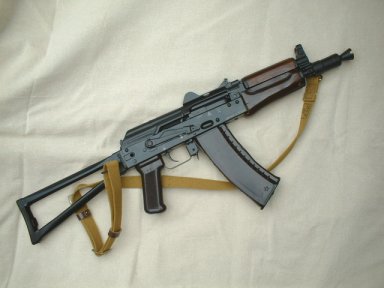 |
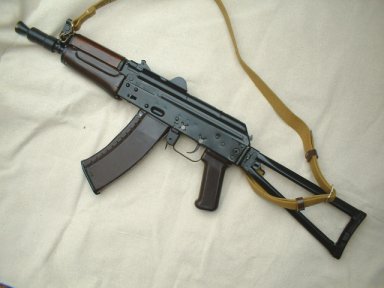 |
| Full view - RHS | Full view - LHS |
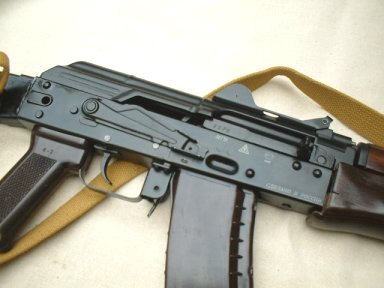 |
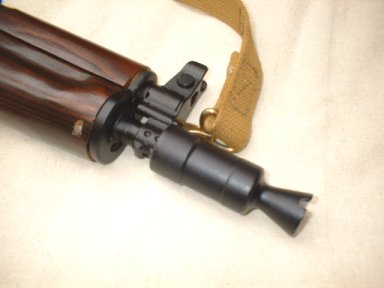 |
| Detail view of receiver inc. selector lever | Unique flash eliminator |
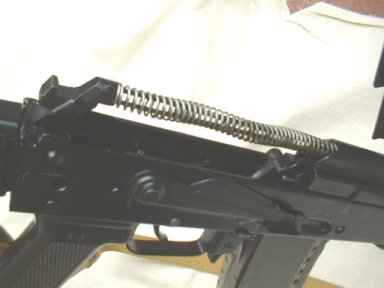 |
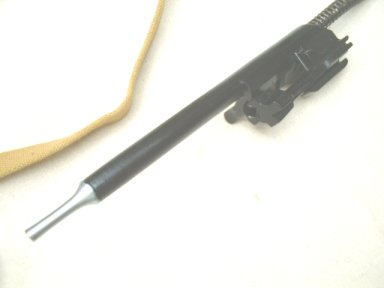 |
| Internally, with top receiver cover flipped open | Bolt assembly inc. gas piston and return spring |
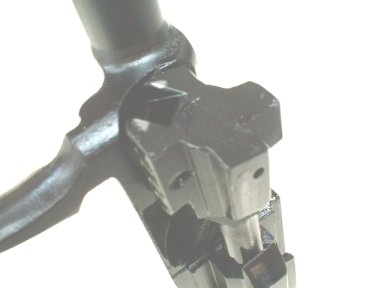 |
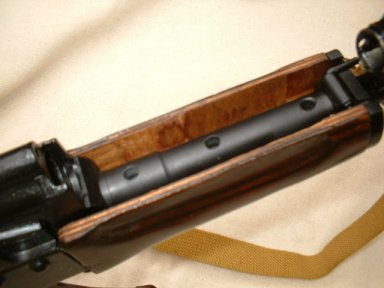 |
| Bolt in detail from below | Top handgrip removed - holes drilled in barrel |
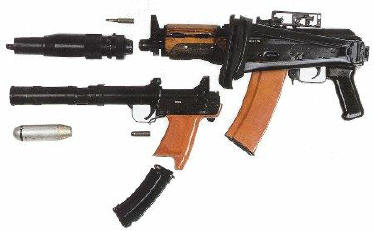
Quick detachable silencer and a special 30mm silenced grenade launcher. Not included in your £395 package!!!!